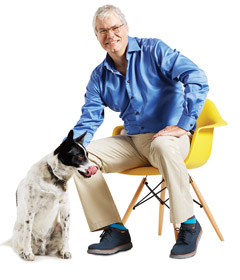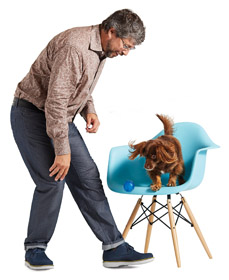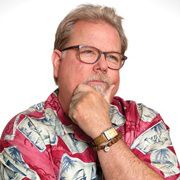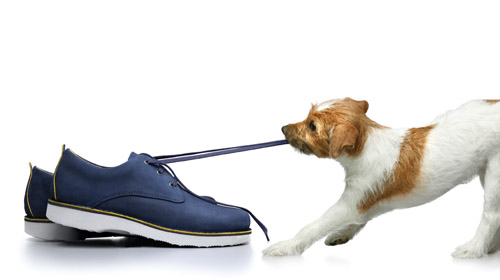Samuel Hubbard Shoe Company is so Marin it almost hurts. It was started in a Mill Valley house, where a small group began designing the first Samuel Hubbard shoes and the company’s launch website. Its founder Bruce Katz is a serial entrepreneur. And for a recent catalog photo shoot, the company sent the models packing. Instead, they opted for real people and real dogs with a shout out to the Marin Humane Society.
The company is old school in so many ways, which is odd since Katz is a tech investor from way back. But Samuel Hubbard is gaining momentum as it makes the argument that folks want to wear something besides sneakers and that those shoes should be comfortable and colorful, with hues like plum, signal yellow, and loden green.
And those are the men’s shoes.
The company is just now getting serious about women’s shoes, in part because 80 percent of the shoes bought in the U.S. are purchased by the fairer sex. But numbers don’t fully explain how Samuel Hubbard began designing kicks for the ladies.
Katz was planning on attending the TED conference, the annual gathering, which explores the intersection of technology, entertainment and design. It has long been a critical place for Silicon Valley types along with lofty thinkers and enlightened capitalists. Katz fit snuggly in the scene, having worked in software design as well as being a venture investor in many Internet startup companies. He has long been a computer geek, building his first computer at age 13.
But this time he wasn’t going to TED chat up software-as-a-service, instead his story was why his shoes were just what the podiatrist ordered. He packed shoes as swag, hoping to gets some mileage out of both word of mouth and the colorful shoes appearing on the feet of intellectual celebrities as well as crossover folks like singer-songwriter Peter Gabriel.
But the women who attended conference had a simple question: Where are our shoes? “They said that this is typical of a TED conference,” Katz said, over lunch at Jason’s Restaurant in Greenbrae.
The TED conference has come in for some criticism as a place that could be more inclusive. But as Katz shows off the women’s shoes in the company’s showroom, a simple conference room with a wall of shoe displays, it’s evident his slow pace tapping into a huge market has more to do with his shoe background than anything else.
“I know men’s shoes, but women’s…,” his voice disappearing as he holds up a “Hubbard Free for Her,” one of the models that came from the men’s line.
one of the models that came from the men’s line.
Dressed in a pink button down and khakis along with shoes from his own line, the 70-year old Katz is mostly arms and legs, his pate topped with grayish hair that has given ground to skin. His voice betrays his eastern roots and he talks with his hands, which at the moment is slowing his ability to attack a salad that could qualify as food porn.
The Katz legacy
Katz is something of legend in the shoe business. He is a third generation shoe guy, his grandfather Samuel founded the Hubbard Shoe company in New Hampshire back when it was shoe country. He spent time in the factory as a kid and his dad Saul was part of the business as well. Katz founded Rockport in 1971 with his dad and built the business into a power in the shoe industry, bringing the idea of comfort to men’s shoes, a place where most shoes were either leather soled and stiff or tennis shoes.
But more than that, Rockport invented the walking shoe and the idea that while folks had been walking around in shoes for decades, shoes designed for walking would make their feet feel better and thus make them happy. Rockport’s marketing was aimed at making walking a legitimate physical activity, and not just something you did during your day. Rockport helped to launch the Walking Magazine.
Rockport began with just $15,000 in capital and was profitable from the start, growing to the point where the Katz’s were going to bring the company public, “We were five weeks away from an IPO,” Katz said. Instead, they sold the company to Reebok International in 1985.
Perhaps sensing that things were going to change with his company in somebody else’s hands, Katz grabbed 24 pairs of his favorite Rockports as a stash for the future.
While Katz’ father stayed with Reebok as a member of the management until he retired, Bruce’s time as president was limited to one year before heading for the exit and stepping out of the shoe business altogether.
Though Katz had millions from the sale, he was not the type to retire. He went into the fish farming business with his brother who likes being on the water and had spent time as Neil Young’s skipper. Farming salmon took Katz to many places including Norway and Ireland. The business eventually was bought out by British Petroleum.
He also was an investor in Novato-based Republic of Tea. Besides supplying cash, Katz helped founders Mel and Patricia Ziegler and Bill Rosenzweig get a publishing deal for a book about the business, The Republic of Tea: The Story the Creation of a Business, as Told Through the Personal Letter of its Founders. He also helped them figure out the business made more sense as a wholesale tea business and not a Starbucks for tea.
He invested in the San Francisco clothing retailer Esprit, a company started by West Marin resident Susie Tompkins. After two years, he sold his shares and moved on to work full time in the technology business. He found Well Engaged, which became the first software company, providing discussion groups for companies such as Amazon as well as for various newspapers around the country. For 14 years, he ran The Well (an early-day version of a Facebook-type community) as it migrated from a dialup bulletin board to a web-based online community.
Katz also took a spin at the mountain biking business. An old friend of mountain biking pioneer and Marin resident Steve Potts, Katz was an investor in Cannondale Bikes.
While there were no shortages of technology companies and tech pursuits that interested Katz, investing in the sector never brought riches. “I invested $42 million in technology, and never made any money,” says Katz. “I loved working in the emerging web business, but it always seemed I was 10 years too early.”
He also took swings at recycling, solar power and the hotel business. But while Katz enjoyed the pursuit of business, nothing seemed to stick. There are many reasons to move from a business, everything from difficult markets to distribution heart aches, but sometimes it’s something much closer to home: The need to move on.
After Rockport, Katz got to fulfill the dream of a lifetime when he designed an aluminum ocean-going ketch, which he had built in the Royal Huisman Shipyard in Holland. Christened The Juliet, the boat has traveled more than 270,000 nautical miles taking Katz to many a port; a more literal expression of the need to move on.
Reinventing the shoe
When it came to getting back into the shoe business, it was a combination of his father Saul passing away in 2012, and his eight-year old daughter showing him a drawing of a shoe. She suggested that she and Katz work on some shoe designs together.
The idea got under his skin. Having done shoes on a large scale with Rockport however, he had no intention of going down that road. “We had 17 factories, 65 engineers,” he said.
Instead his vision was shoes on a smaller scale. “I was seriously thinking of selling shoes like grandma’s jam, doing something small out of the garage,” he said. “Maybe do 100,000 pairs a year on the web, something practical, that would be a good business.”
That vision morphed into Samuel Hubbard Shoes. The business is named in part for Katz’s grandfather and his New Hampshire shoe factory, Hubbard Shoes. But it borrows in one large respect from Rockport. That company became something big because it literally invented a segment for itself by elevating walking from putting one foot in front of the other to a separate pursuit that had to do not with getting from here to there, but rather a fitness activity.
Likewise, Katz and Co. are trying to once again reinvent the shoe. “This is the unsneaker, we are creating a new category,” Katz says, rolling into sales mode. “I’ve never really liked the way sneakers feel, your feet sweat, the shoes might be super comfortable, but at the end of the day they can get pretty sweaty and smelly. Leather shoes are much healthier on your feet, and stay cool and dry naturally.”
A key demographic for the company are 25- to 30-year-old males, who likely have spent most of their years in sneakers, everything from high tech joggers to old school Air Jordans. “They see these shoes as retro,” Katz says.
With price points from $215 to $375 a pair, those males probably won’t be enough for Samuel Hubbard. Turns out that Baby Boomers looking for comfy kicks are another critical group. Full disclosure here, I’mat the tail end of that particular demographic. Moreover I like shoes. Not only do I find them ideal for keeping my feet warm and dry, they are also an expression of your sense of style, or lack thereof. Color doesn’t scare me; I have sneakers in red and blue. And I have wing tips that match those colors as well.
And still, I’m not entirely sold on Hubbard’s shoes. Some of them strike me as a little clunky, sacrificing style for comfort. I’m not condemning them all mind you, but a few strike me as perfect for postman, who seem to be doomed to wearing shoes that not only will see them through snow and the gloom of night, but border on orthopedic.
But then I like Hawaiian shirts, so clearly I am not one to judge.
Marketing to retailers
Katz confesses that the company had more than a little push back from retailers when they began shopping the new shoe brand around. “They said we could never sell a shoe for that much,” Katz said, his voice chock full of incredulity. “I said, ‘So you have no veterinarians in town? No lawyers?’”
A word here about how Samuel Hubbard sells its shoes because it goes back to Katz being an old school guy. You will not find the brand on Amazon, nor will you be able to purchase “Sammy’s” from Amazon’s shoe cousin, Zappo’s. That is because Katz is mostly selling his shoes through independent shoe stores.
There is an exception; you can find Samuel Hubbard at Nordstrom in 21 different styles, but not on sale. The company has a philosophy that their shoes have one price, the full retail tally. “Nordstrom said they wanted to put our shoes in their sale catalog, and we told them no, our shoes have one price, no sales, no promos,” Katz said.
The company’s relationship with the upscale retailer is interesting. Katz tells a story about sitting with Nordstrom’s buyers and pitching the shoe line, showing them the oxfords, wing tips and boots in very standard flavors, brown and black. But they had brought along some of the colorful choices as well, not planning to push them. At the end of the meeting, the buyers said they liked the line and agreed to bring them into stores. Everybody shook hands and was heading out the door, when one of the buyers came back and asked if they could send him a pair of the lime green shoes he had seen.
So far, the brand is doing pretty well. In 2015, the privately held company posted $2 million in sales. The next year that figure jumped to $12 million. Katz had said publically that he thought 2017 would find the company in the black, but now he is thinking that will occur next year. With the addition of a women’s line of shoes, sales are likely to jump, though it remains to be seen if that will lead the company to profit.
Partnering with Marin Humane Society
Companies that underperform are referred to on Wall Street as dogs, and where Hubbard is concerned that could prove confusing. The company’s shoes are already tied to man’s best friend in the best kind of way. A catalog of Hubbard’s products features no less than 19 dogs, with a beautiful Afghan holding a pair of navy blue Hubbard Fast on the cover. On the inside cover, Katz is seated with his two dogs, Hope and Wonder.
The inspiration for putting canines front and center was the idea that Samuel Hubbard shoes are ideal for heading out for a long walk with your pooch. The catalog copy reads, “It’s our love for the four-legged variety that first drew us to Marin Humane Society. They reunite lost pets with worried families, use dogs as a tool of connection with autistic children, and find homes for all kinds of critters.”
heading out for a long walk with your pooch. The catalog copy reads, “It’s our love for the four-legged variety that first drew us to Marin Humane Society. They reunite lost pets with worried families, use dogs as a tool of connection with autistic children, and find homes for all kinds of critters.”
The sales book also has a shot of John Reese, the Humane Society’s Chief Administrative Officer along with his dog, Owen. “At Marin Humane, we are matchmakers that complete families and provide resources to keep those families together,” it says next to the photo. Chip Smith, a board member can also be found in those pages along with his dog Hank, a Marin Humane alum.
Regardless of the walking hook, Samuel Hubbard couldn’t have found an organization that elicits more smiles than Marin Humane. While animal shelters all over the country are places to adopt animals, Marin Humane goes far beyond that simple model. Since 1907, the nonprofit has advocated for animals as well as developing innovative programs that have joined the community with animals in ways that are outside the kennel.
Jumping for Joy is a six-week class that brings together man’s best friend with kids on the autism spectrum. The kids are teamed with a friendly dog and both get on the agility course. The unique course helps kids build confidence as well as social skills while building a bond with the dogs.
Compassion Corner is another example of an inventive program. Located at the Marin Humane’s Novato campus, the program pairs dogs, cats and even rabbits with those in the community with physical or cognitive challenges for a little gentle interaction.
Marin Humane also offers an animal-assisted therapy program that brings animals and their guardians to visit with folks at 58 different care facilities throughout Marin like senior communities, convalescent hospitals and special day class in Marin schools. The animals bring comfort and companionship to places where the environment can sometimes seem hard or lonely.
And Marin Humane has made a name for itself by rescuing animals from disasters ranging from Hurricanes like Katrina and more recently, Irma. It also pitched in by offering free shelter to animals stranded by the fires in Napa and Sonoma.
While Marin Humane has a long-standing reputation, Samuel Hubbard is pretty young, even if you look at in Dog Years. But they have one big thing in their favor; Katz is a big time Shoe Dog. A Shoe Dog is industry slang for someone who is a veteran of the shoe biz. And while Katz has been in and out of the shoe biz for plenty of years, he shows no signs of slowing down.
How you can help
The Marin Humane Society is always looking for more; more funds, more volunteers, more adoptions. If you want to lend a hand by making a donation, volunteering or making a forever home for a lucky animal, please visit www.marinhumane.org for more information.
Author
-

Bill Meagher is a contributing editor at NorthBay biz magazine. He is also a senior editor for The Deal, a Manhattan-based digital financial news outlet where he covers alternative investment, micro and smallcap equity finance, and the intersection of cannabis and institutional investment. He also does investigative reporting. He can be reached with news tips and legal threats at bmeagher@northbaybiz.com.
View all posts




